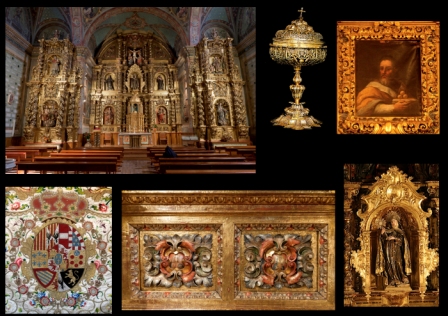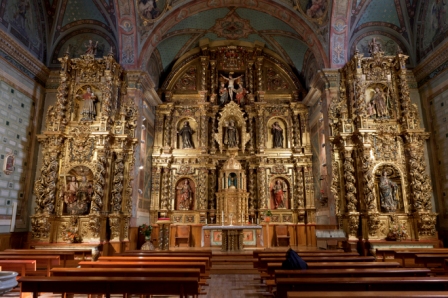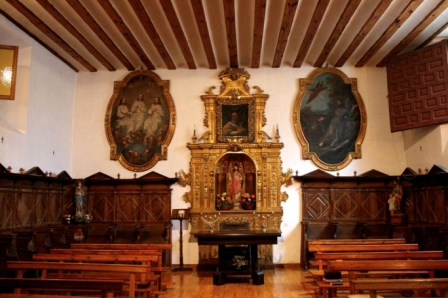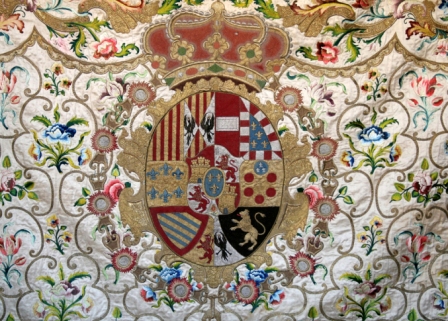August 29th
lecture series
ESTELLA ES ARTE-LIZARRA ARTEA DA
Of golden color. The arts of the Baroque in the Poor Clares
D. Ricardo Fernández Gracia
Chair of Navarrese Heritage and Art
The role of color in art has always been of special significance, especially in the Baroque period, when through color, light, ornament or movement, the faithful were captivated in sacred spaces, creating true heavens on earth and at the same time a theatrum sacrum, hallucinating spaces, typical of the Baroque, in the context of a culture and an art that wants to captivate through the senses, much more vulnerable than the intellect. Color became the master of the surfaces of the naves through rich hangings or tapestries, of the headers and headwalls of the chapels by means of enormous altarpieces that covered all their surfaces like a great curtain. The frames of the paintings were enriched both in the work of carving and in their polychrome decorations, the sacred vessels incorporated in many cases the technique of gilded silver with colored stones and even jewels and brilliants, and the liturgical ornaments showed on their surfaces rich and lively designs executed with a delicate technique of what we can call acu pictae.
All that chromatic symphony stood out even more and moved even more those who contemplated those sets because the gold, in the altarpieces, in the frames of the paintings, applied on the silver or in the form of thread in the embroideries, provided the pieces and the sets with a special richness, brightness and mystery, always evoking the divinity.
The example of the Poor Clares of Estella is one more of the many that, whether built or not in the 17th century, baroque their interior space in order to achieve those authentic caelum in terris. In comparison with the exteriors of their church and the arches of their enormous cloister, the largest of a female cloister in Navarre, built with humble and monochrome brick, the interiors of their church and of some spaces of the conventual complex, such as the upper and lower choirs, were notoriously opulent, ostentatious and sumptuous.

The historical-artistic heritage of the Poor Clares highlights the taste for color and gilding during the Baroque centuries
Unfortunately, the hangings with which the interior of the nave and Wayside Cross were covered during the solemnities have not been preserved. As in other convents of reference letter in the Hispanic area, like that of the Conceptionists of Ágreda, the Estelles nuns were made with rich fabrics, possibly of Granada origin, where there were very outstanding manufactures that worked the linen with the silk threads generally of red color. The whole textile ensemble of red silk damask, which had arrived at the convent in 1706, was sold in 1922 and according to descriptions of this last year consisted of 564 meters with a width of 56 cms.
The altarpieces constitute an outstanding ensemble in Tierra Estella. The largest was executed by the master of the Pamplona workshop Juan Barón de Guerendiáin (†1694) and the collateral ones by the Estella-based sculptor Vicente López Frías (†1703). It is no coincidence that for the first one an artist from the capital of Navarre was requested, at a time when there were no great masters in the city of the Ega, something that at the end of the century and facing the following century no longer happened with the appearance of outstanding retablists such as Vicente López Frías and above all the figure of greatest projection, Juan Ángel Nagusia. The same happened with the gilders of both projects -Juan Andrés de Armendáriz, Diego de Astiz and Francisco de Arteta-, and even for the sculpture itself, which in the larger one is the work of the Madrid sculptor Juan Ruiz, established in Pamplona at that time.
Regarding conditions, prices, deadlines, materials, description and analysis, we refer to the programs of study already published (article in the Revista Príncipe de Viana, no. 190, (1990) and the monograph El retablo barroco en Navarra, Pamplona, Gobierno de Navarra, 2003). We will mention here some of the valuations of the piece, such as the fact that it was one of the first to be required to cover the entire front of the presbytery chancel in order to configure a large stage for the liturgy and celebrations. Likewise, the use of delicate salomónicas covered with vines, a layout with the main street recessed to look for movement, the existence of trapoyas in the primitive tabernacle and the fine decoration of cartouches are data that ascribe the altarpiece to the really prevailing trend of baroque. Something that changed very soon was the location in the first body of the altarpiece of the sculpture of the Immaculate, today in one of the collaterals, that had all its sense in a temple of the feminine branch of the Franciscans, standard bearers of the cult around the Immaculate Conception. This last sculpture was baroque in 1704 with the addition of several hairpieces, which Martín de Tovar y Asensio, resident at that time in Corella, took care of.
The sculptures of the altarpiece, the martyrs Catalina and Bárbara, worshipped in the city and the convent since the Middle Ages average, the patron saint somewhat retouched in the 18th century and the saints Francisco and Antonio, are really somewhat rigid but of correct execution and in the realistic tendency inaugurated in the Hispanic sculpture decades before.
The addition of the collaterals twenty years later came to fill in that scenario of the head of the temple colored and singularly gilded. Thus the set of altarpieces, illuminated by the dim light of candles, glowed like an ember in the gloom of the temples, insinuating itself to the public eye like a celestial apparition. In addition, with the vibration of their forms, the density of their decoration and the multiplicity of their images gave the temple, with its rigid, inert walls cut at right angles, a sensation of mobility and expansion of space that was structurally lacking. The altarpieces thus provoked an illusionism very characteristic of the Baroque, in which the dichotomy between background and figure, between surface and reality was only deceptively resolved.

Main altarpiece, by Juan Barón, 1678
Collateral altarpieces by Vicente López Frías, 1698
The paintings were located singularly in the low choir and the high choir, with such exceptional pieces as the trifacial Trinity, sent to the convent by the indiano of Puente la Reina Don Miguel Francisco Gambarte, who was prodigal in the endowment of the chapel of the Virgin of the Snows in the parish of San Pedro of his native town. Gambarte had a niece in Estella who took the habit in 1750 and professed in 1751 and for that reason he sent the canvas and other pieces, such as a rich gilded silver ciborium.

Bass choir
Other outstanding canvases are the large one of Santo Domingo in Soriano, or the one of San Nicolás framed in the attic of the altarpiece of the lower choir, which has the richest gilded framework of all the conventual patrimony. There is no lack of iconographies linked to the saints of the order and the Immaculate Conception, all the sculptures with precious polychrome and richly colored canvases.
Among the textile pieces where gold, silver and colored threads are masterfully combined, the great terno that is preserved complete, including a large canopy and frontal, stands out. Its confection was contracted in 1762 for 1,700 pesos with the embroiderer José Gualba, resident in Zaragoza, and it was stated that it should be like that of the Benedictine nuns of Estella. issue The high amount, 700 pesos more than the one ordered for the cathedral of Pamplona a few years earlier, is due to the fact that it would have a greater number of pieces: chasuble, dalmatics, cape, lectern cloth, large frontal for the main altar, frontals for the collaterals, humeral, pulpit cloth and pallium, which makes the ensemble something truly exceptional.

Altar frontal with the arms of the Hispanic Monarchy
José Gualba, Zarazgoza, 1762
